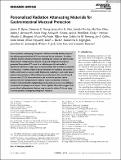Personalized Radiation Attenuating Materials for Gastrointestinal Mucosal Protection
Author(s)
Byrne, James D; Young, Cameron C; Chu, Jacqueline N; Pursley, Jennifer; Chen, Mu Xian; Wentworth, Adam J; Feng, Annie; Kirtane, Ameya R; Remillard, Kyla A; Hancox, Cindy I; Bhagwat, Mandar S; Machado, Nicole; Hua, Tiffany; Tamang, Siddartha M; Collins, Joy E; Ishida, Keiko; Hayward, Alison; Becker, Sarah L; Edgington, Samantha K; Schoenfeld, Jonathan D; Jeck, William R; Hur, Chin; Traverso, Giovanni; ... Show more Show less
DownloadPublished version (3.154Mb)
Publisher with Creative Commons License
Publisher with Creative Commons License
Creative Commons Attribution
Terms of use
Metadata
Show full item recordAbstract
Cancer patients undergoing therapeutic radiation routinely develop injury of the adjacent gastrointestinal (GI) tract mucosa due to treatment. To reduce radiation dose to critical GI structures including the rectum and oral mucosa, 3D-printed GI radioprotective devices composed of high-Z materials are generated from patient CT scans. In a radiation proctitis rat model, a significant reduction in crypt injury is demonstrated with the device compared to without (p < 0.0087). Optimal device placement for radiation attenuation is further confirmed in a swine model. Dosimetric modeling in oral cavity cancer patients demonstrates a 30% radiation dose reduction to the normal buccal mucosa and a 15.2% dose reduction in the rectum for prostate cancer patients with the radioprotectant material in place compared to without. Finally, it is found that the rectal radioprotectant device is more cost-effective compared to a hydrogel rectal spacer. Taken together, these data suggest that personalized radioprotectant devices may be used to reduce GI tissue injury in cancer patients undergoing therapeutic radiation.
Date issued
2021Department
Koch Institute for Integrative Cancer Research at MIT; Massachusetts Institute of Technology. Department of Mechanical Engineering; Massachusetts Institute of Technology. Division of Comparative MedicineJournal
Advanced Science
Publisher
Wiley
Citation
Byrne, James D, Young, Cameron C, Chu, Jacqueline N, Pursley, Jennifer, Chen, Mu Xian et al. 2021. "Personalized Radiation Attenuating Materials for Gastrointestinal Mucosal Protection." Advanced Science, 8 (12).
Version: Final published version